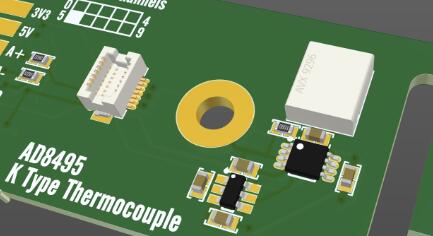Thermocouple connectors are used to connect one thermocouple wire to another wire. The connector provides a fast and convenient method of connecting and disconnecting. The pins and sockets of thermocouple connectors should be made of the same material as the thermocouple wires to avoid any measurement errors. The thermocouple connector uses the ANSI color coding standard for quick visual recognition of thermocouple calibration in connector design.

In thermocouple connectors, the positive and negative electrode inserts are made of thermoelectric alloys with identical thermocouple models to reduce temperature measurement errors caused by the introduction of the connector. It should be noted that the fixing screws of the two positive and negative electrode inserts are of the third type of metal. Therefore, during the temperature measurement process, it is necessary to ensure that the overall temperature of the connector is consistent, otherwise according to the law of the middle metal of the thermocouple, temperature measurement errors may occur.
A thermocouple is a commonly used temperature-measuring element that can be directly used for temperature measurement and converts the temperature signal into a thermoelectric electromotive force signal, which is then converted into the temperature of the measured medium through a secondary instrument. Thermocouples have various advantages such as simple structure, convenient manufacturing, wide measurement range, high accuracy, small inertia, and easy remote transmission of output signals, making them widely used in temperature measurement. In addition, thermocouples are also active sensors that do not require an external power source during measurement and are extremely convenient to use. They are commonly used to measure the temperature of gases or liquids in furnaces, pipelines, and the surface temperature of solids.
Classification of thermocouple connectors
Commonly used thermocouples can be divided into standard thermocouples and non-standard thermocouples.
1) Standard thermocouples refer to thermocouples that have a national standard that specifies the relationship between their thermal potential and temperature, allowable errors, and a unified standard graduation table. Standard thermocouples have accompanying display instruments for selection.
2) Non-standard thermocouples refer to thermocouples that do not meet the conditions of standard thermocouples, often manifested as being inferior to standard thermocouples by an order of magnitude in their usage range, without a unified graduation table, and mainly used for measurement in certain special occasions.
3) Thermocouples can be divided into six types according to their fixed device types: non-fixed device type, threaded type, fixed flange type, movable flange type, movable flange square type, and conical protective tube type.
4) Thermocouples can be divided into four types based on their performance and structure: detachable thermocouples, flameproof thermocouples, armored thermocouples, and spring-fixed thermocouples for special purposes.
Thermocouples use the thermoelectric effect for temperature measurement. The thermoelectric effect refers to the phenomenon where two different components of conductors are connected at both ends to form a circuit. When the temperature of the two junction points is different, an electromotive force is generated in the circuit, which is called thermal electromotive force. We will refer to the end directly used for measuring the temperature of the medium as the working end or measuring end, and the end not directly used for measuring the temperature of the medium as the cold end or compensation end. When the cold end is connected to a display instrument or other supporting instruments, the thermoelectric potential generated by the thermocouple will be displayed on the instrument.
The thermal electromotive force generated by thermocouples consists of two parts, one is the contact electromotive force of two types of conductors, and the other is the thermoelectric electromotive force of a single conductor. Therefore, the size of the thermoelectric potential is only related to the conductor material and the temperature of the two junction points that make up the thermocouple and is not related to the shape and size of the thermocouple and other parameters. When the two electrode materials of the thermocouple are fixed, the thermoelectric electromotive force is the functional difference of the temperature at the two junction points.
The thermocouple PCB connector is an important component connecting the thermocouple and the temperature transmitter, used to transmit the temperature signal of the thermocouple to the temperature transmitter for processing and conversion. The function of thermocouple connectors is to ensure stable and reliable signal transmission. If the connection is not implemented properly, signal transmission errors will occur, affecting the stability and reliability of the production process.